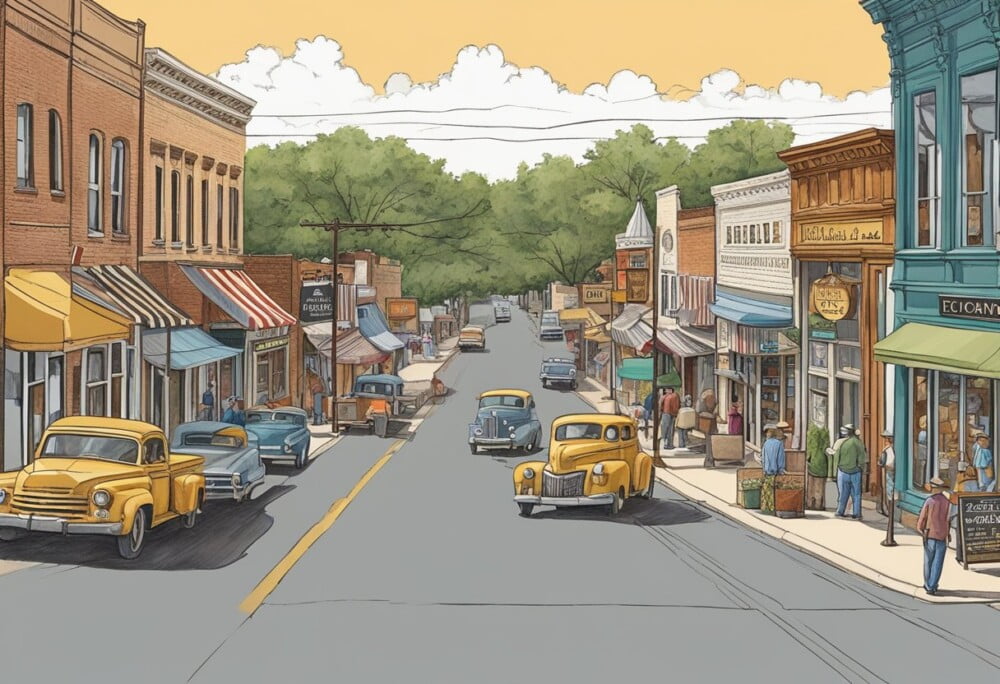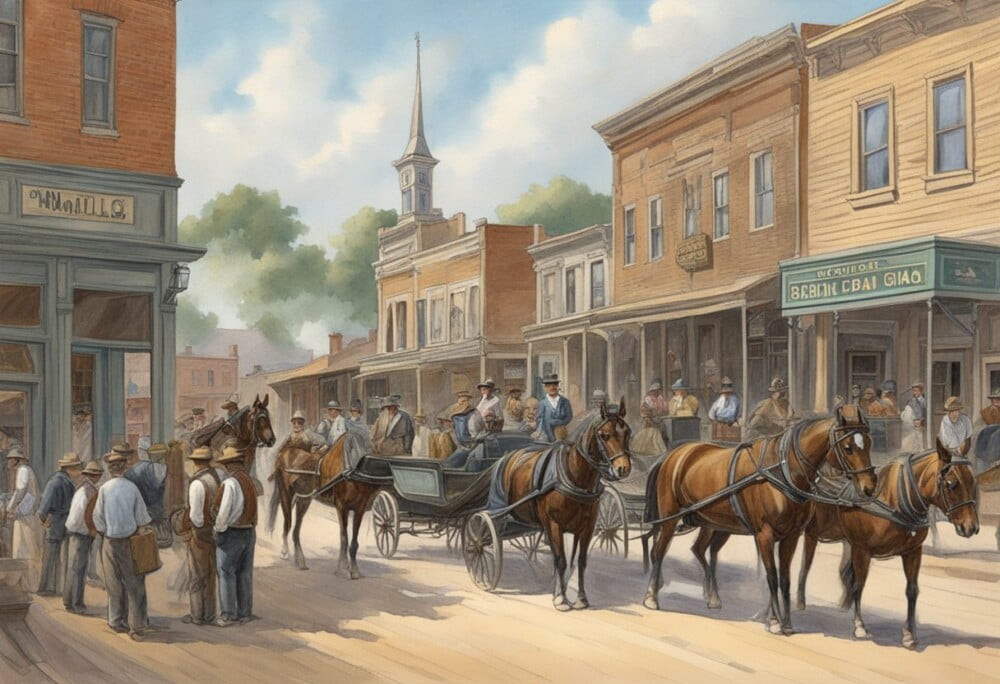by Ray Roman Updated on Dec 30, 2023
Nestled in the heart of southern Oklahoma, the city of Madill serves as a portal to the region’s cultural and agricultural history. Established at the dawn of the 20th century, Madill was founded within the fertile lands once roamed by Native American tribes.
With a rich history that commenced with farming and ranching as its economic bedrock, the city evolved from its simple agrarian roots to become the county seat of Marshall County.

Through the years, Madill has woven a tapestry of local traditions and community spirit, as it has steadily adapted to changing economic tides.
From its initial establishment to the present day, Madill has remained intimately tied to the rhythms of agrarian life while also embracing the nuances of modernity.
The city’s narrative is studded with significant landmarks and milestones that trace the trajectory of its enduring legacy.
Key Takeaways
- Madill is a historically rich city rooted in agriculture.
- The city has experienced steady growth and change since its founding.
- Madill’s landmarks highlight its vibrant historical narrative.
Origins of Madill

Your exploration of Madill’s history begins with its deep roots in Native American heritage and transitions into its subsequent European settlement.
Native American History
Before European settlers arrived, the area known today as Madill was inhabited by the Choctaw and Chickasaw tribes.
These Native American groups were part of the more extensive relocation forced upon many tribes by the United States government, a tragic event known as the Trail of Tears. This relocation dramatically shaped the region’s early history.
European Settlement
The foundation of Madill as a town was laid in 1900 by William N. Taliaferro, who originally settled in the area in 1886. Madill’s development coincided with the rich agricultural surroundings of the time.
It resided in what was then called Pickens County, part of the Chickasaw Nation in Indian Territory. Taliaferro’s influence on Madill was significant, given his ownership of a large farm and several ranches nearby. More about the city’s founder can be found reflecting on his impact on the town’s early growth.
City Founding and Growth
Your exploration of Madill’s history begins with its founding and expands through significant periods of development that have shaped the town into what you see today.
Establishment of Madill
Madill was officially founded in 1901, named in honor of George Alexander Madill, an influential attorney and politician. Its inception was tied closely to the transportation opportunities afforded by the nearby Santa Fe Railroad. More about Madill’s origins.
Early 20th Century Development
In its early years, Madill underwent rapid growth due to its strategic position. The Corner Drug building, for instance, remains a historical marker, dating back to 1906 and representing the early commercial development powered by pioneers like D.B. Taliaferro. Learn about Madill’s early structures.
Post-World War II Expansion
Following World War II, Madill’s growth was bolstered by the completion of the Denison Dam in 1944 and the creation of Lake Texoma.
This development heralded a new era of tourism and economic prosperity that you can still witness today, highlighted by events such as the annual National Sand Bass Festival started in 1963. Discover Madill’s post-war growth.
Economic Evolution
Madill, Oklahoma, has witnessed significant changes in its economic landscape, evolving from an agriculture-based economy to embracing industrial and commercial diversification.
Agricultural Beginnings
Initially, your town’s economy was firmly rooted in agriculture. The fertile land surrounding Madill supported crops and livestock, which were the primary sources of income for the early settlers.
Cotton, in particular, played a vital role in establishing Madill’s economic foundation. As you delve into historical records, you’ll find that the 1920s showed a surge in population, hinting at prosperous farming operations during that era.
Industrial and Commercial Diversification
In the latter half of the 20th century, Madill’s economy began to diversify beyond agriculture. The introduction of manufacturing jobs and commercial businesses changed the economic character of the town.
A variety of local establishments, such as the historical Corner Drug building, which dates back to 1906, illustrate Madill’s commercial evolution.
Additionally, the growth in population to 3,770 by 2010 signals an expanding economy with more diverse employment opportunities beyond traditional farming.
Cultural and Social Aspects
Madill, Oklahoma, boasts a unique blend of cultural heritage and social engagement that reflects in its local customs and educational system.
You’ll find that the community’s pride in their history is evident in their traditions and institutions.
Local Traditions
Festivals: You can immerse yourself in the Sand Bass Festival, an annual event celebrating the local fishing culture. Held every March, this festival revolves around a significant fishing tournament in the area.
Historic Sites: Madill is home to notable historic landmarks, such as the Marshall County Courthouse and Worth Hotel, which have been preserved as part of the town’s heritage. These sites add to the town’s character and offer a glimpse into its bygone era.
Educational Institutions
Public Schools: Your children have the opportunity to attend schools within the Madill School District, where they gain knowledge not just academically but also about the area’s rich history and societal values.
Higher Education: If you’re seeking higher education, options are available in the vicinity of Madill. The presence of such institutions contributes to the intellectual growth and cultural enrichment of the community.
Historical Landmarks and Preservation
In Madill, Oklahoma, you will find several historical landmarks that reflect the rich history and heritage of the area. Preserving these sites offers a glimpse into the past for both residents and visitors alike.
The Marshall County Courthouse, standing since its designation in (NR 84003154), serves as a prominent symbol of Madill’s commitment to preserving its historical architecture.
Similarly, the Worth Hotel, now known as the Plaza Professional Building, has been preserved and listed in the National Register of Historic Places (NR 85000846). This particular building stands as a testament to the early 20th-century architecture.
- Notable Historic Sites in Madill:
- Marshall County Courthouse
- Worth Hotel (Plaza Professional Building)
Madill also honors its history through the preservation of its cultural narratives. The town’s local newspaper, the Madill Record, continues to operate, weaving the current events of the day into the fabric of the town’s history.
This newspaper began its journey as the Oakland News in (1895)(https://www.okhistory.org/publications/enc/entry.php?entry=MA004), and to this day, it remains an integral part of the community’s effort to document and preserve its story.
Your understanding of Madill’s identity is enriched through these preservation efforts, offering a physical connection to Oklahoma’s past.
These landmarks are not just structures but are storied places where the echoes of bygone eras still resonate, allowing you to walk amidst history and appreciate the foundation of this Oklahoma town.
Frequently Asked Questions
In this section, you’ll find concise answers to some of the most commonly asked questions about the history of Madill, Oklahoma, highlighting its development, cultural significance, and demographic trends.
What historical events shaped the development of Madill, Oklahoma?
Madill’s development was significantly influenced by the establishment of the Arbuckle oil field in 1904 and its subsequent boom in 1924.
The town’s foundation in 1901 and its proximity to the Santa Fe Railroad were also pivotal to its early growth.
What cultural or economic contributions is Madill, Oklahoma known for?
Madill is notably associated with the annual National Sand Bass Festival, which emphasizes the town’s cultural identity.
Economically, it was historically marked by contributions from the nearby mineral springs and oil seep which played a role in regional development.
How has the population of Madill, Oklahoma changed over time?
The population of Madill has experienced growth since its founding. It rose from 3,410 in 2000 to 3,770 by the 2010 census, reflecting a 10.8 percent increase which indicates steady expansion.
What is the historical significance of Marshall County in relation to Madill?
Madill serves as the county seat for Marshall County, suggesting its political and administrative significance. Initially, the town was an integral part of Chickasaw Nation in Indian Territory before statehood and it played a key role in the county’s development.
Can you describe the demographic trends in Madill, Oklahoma throughout its history?
Throughout its history, Madill’s demographic trends reflect a predominance of the ethnic groups that originally settled in the area.
However, it has faced challenging moments, as indicated by events in 1904 where Black residents were driven out of the town.
What key landmarks or historical sites can be found in Madill, Oklahoma?
Key landmarks in Madill include the historical sites related to the early settlers and the expansion of the oil industry. The former quarters for Pure Oil Company employees known as Pure Camp are notable.
Additionally, the town’s historical downtown area offers a look into its past through preserved architecture and local businesses.

